
Search
The Renewable Energy site for Do-It-Yourselfers
Testing the Benefit of a Reflector
on a Vertical Solar Space and Water Heating Collector
|
As previously reported, the heat output for my
$2K
solar space and water heating system during the spring has been a bit
disappointing. Spring is a time I would like it to be producing heat for
both space heating and water heating, the collector is basically just keeping up with water
heating needs.
This section goes over one potential solution to increase energy
production in the spring. The solution is to add a reflector below the
collector and extending out in front of the collector. The
reflector is angled such that it takes the rays from the very high in
the sky sun and reflects them onto the collector.
This page goes over a test of a very rough prototype of this kind of
reflector to see how effective it is in increasing energy input to the
system.
The bottom line result is
that the reflector is very effective in increasing the collector heat
output.
|
|
Table of Contents
- Test Setup...
- Conducting the test...
- Results...
- Data Plots...
- Comparable day without
reflector...
- Conclusions...
- Comparison to other
reflector tests...
Test Setup
This is a test to verify that a reflector placed below and in front of the
vertical collector for my $2K solar space and water heating system will actually
provide a worthwhile gain in performance. This is just a rough test setup
and its ugly, but the idea is just to confirm that it works before
spending the time to do a nicer version. It is also larger than I
would like to end up using, but its easier to get an idea of the benefit with a
larger reflector. Given that it does appear to be significantly
improving performance, I will be going ahead and doing a smaller "production" version.
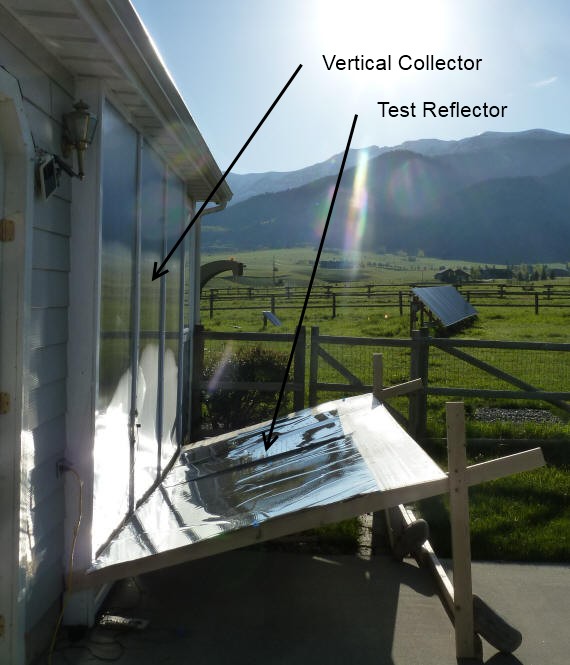
The test reflector is made with a tacked together 2 by 4 frame. The
backing for the reflector is two sheets of twinwall that were used for
packing material on my last order (lots of holes in them). The reflector
material is some aluminized Mylar I had leftover from the Heliostat project.
The size of the reflector is 58 inches by 126 inches wide for 50.8 sf.
The up angle on the reflector is about 15 degrees as determined from this
test on the simulator. Since we are approaching the summer solstice
the sun is near its highest elevation of the year. This reflector angle
results in an incidence angle for the reflected rays of about 45 degrees on the
collector. This seems about right -- if the tilt angle is increased, the
effective area of the reflector is reduced, and all of the reflected rays are
concentrated on a relatively small area at the bottom of the collector. If
the tilt angle is flattened out, the reflected rays cover more of the collector
area, but the incidence angle of the reflected rays on the collector gets so
shallow that I fear at lot of the reflected energy would just be reflected off
the collector glazing.
Conducting the Test
This reflector geometry produces a reflected light pattern on the collector
around midday that looks like this:
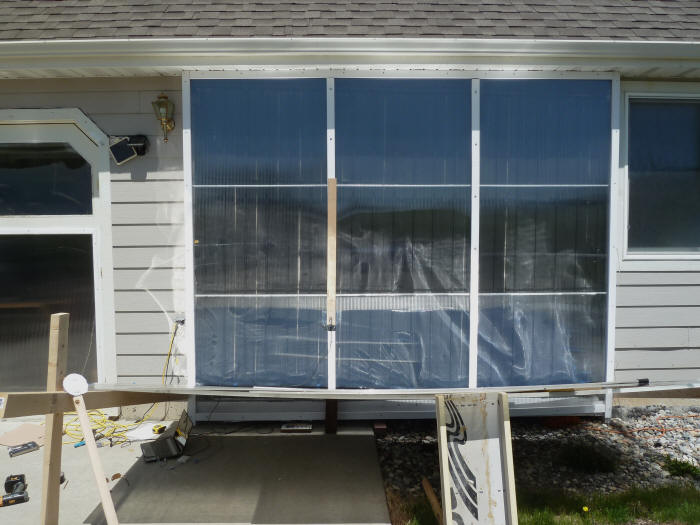
You can see the top of the reflected rays pattern about
half way up the collector. The blotchiness of the patter is due to the
aluminized Mylar not lying quite flat on the twinwall supports and on the
twinwall having some wows in it.
Note that its not quite solar noon on the collector in
that there is an area to the right side of the collector that is not yet getting
reflected light, and there is an area to left side where the reflected light is
hitting to the left of the collector on the wall. This is why there is
some benefit in having the reflector be wider than the collector -- see this
test for more details on how the reflected ray
pattern moves across the collector over the day...
Note also that the eave is shadowing about the top 1 ft
of the collector -- this is even though the eave is only about 8 inches deep --
something to look out for on vertical collectors that you want to keep producing
in the summer.
Its also (maybe) interesting to note that the underside
of the eave (the soffit area) is lit up by reflected light. I guess that
may be light from the reflector that is then reflected off the surface of the
twinwall collector glazing? Its not all that bright, but certainly a
non-zero loss.
To measure the solar radiation levels, I used an Apogee pyranometer on a
rotating arm such that I could easily rotate it down to get a reading inside the
reflector pattern and then up to get a reading above the reflected pattern on
the top part of the collector. In this way, I can get a reading at any
given time how much stronger the radiation is in the reflected light pattern and
use this to calculate the energy input gain for the reflector.
To get around the blotchiness of the
reflected light pattern I placed a flat glass mirror on the Mylar reflector such
that the reflection from the flat mirror covered the pyranometer. This
flat mirror had to be moved as the test progressed to keep it centered on the
pyranometer.
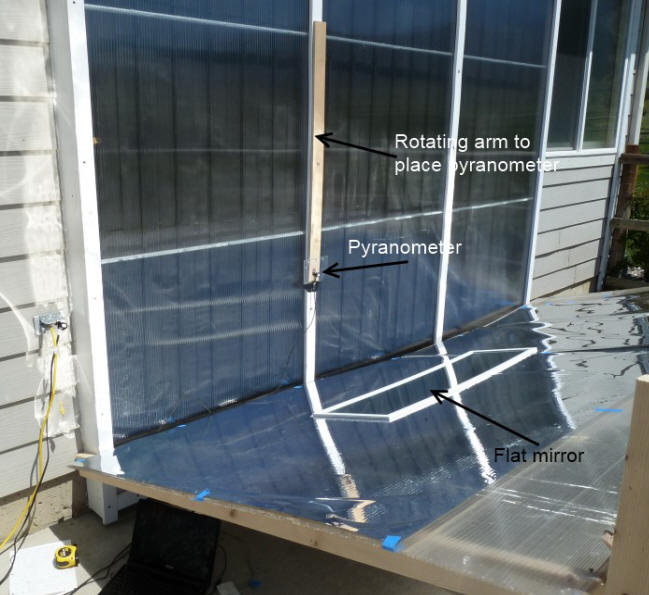
By knowing the size of the reflected pattern and the solar radiation levels
inside and outside the reflected pattern, I can calculate how much energy the
reflector is adding.
The plot of logged solar radiation readings for the day are at the end of
this page.
Results
This table gives the estimate for the benefit of the reflector for three
times during the morning. The clouds came in in the afternoon,
so no data for the afternoon, but it should be symmetrical with the morning
results.
| Time |
Collector |
Reflector |
Increase due to reflector |
Area
(sm) |
Radiation(w/sm) |
Power
(watts) |
Area
reflected pattern
(sm) |
Radiation
(w/sm) |
Reflector Rad
Increment
(w/sm) |
Reflected
Energy Increment
(watts) |
Energy
Increase
(percentage) |
| 9:07 am |
7.05 |
309 |
2178 |
2.97 |
1000 |
691 |
2052 |
94% |
| 11:00 am |
7.05 |
473 |
3335 |
3.47 |
900 |
427 |
1481 |
44% |
| 12:11 pm |
7.05 |
470 |
3313 |
4.53 |
966 |
496 |
2245 |
68% |
So, this reflector that is only about half the size of the main collector
certainly earns its keep with some pretty healthy increases in collector energy output.
A lot of this is due to the fact that the reflector is oriented nearly
perpendicular to the incoming solar rays, so its area is nearly 100% effective.
On the other hand, with the sun elevation up at 65 degrees, the incidence angle
on the vertical collector itself is also at 65 degrees and its effective area is only
about 40 percent of its actual area. That is, reflectors are very
effective for vertical collectors in the summer.
I did not include the area of the collector that is shadowed by the eave in
any of the above calculations, since this is basically lost area.
These pictures show the reflected patterns for some times during the morning:
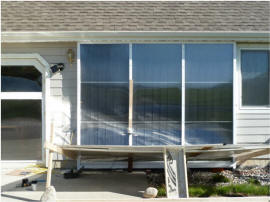
Reflected pattern at 9 am |
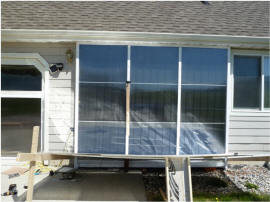
Reflected pattern 11 am |
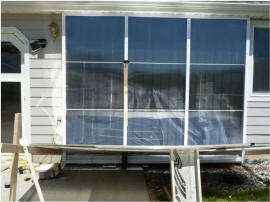
Reflected pattern 12 noon |
Note how the early day reflected pattern is skewed off to the west -- its
only around noon that the pattern aligns exactly with the collector. The
reflected pattern skews off to the east as the sun passes noon and heads west,
but the clouds came out in the afternoon, so no pictures of that. So,
there is some benefit to making the reflector wider if that can be done easily.
This is a thermal image of the reflected pattern:
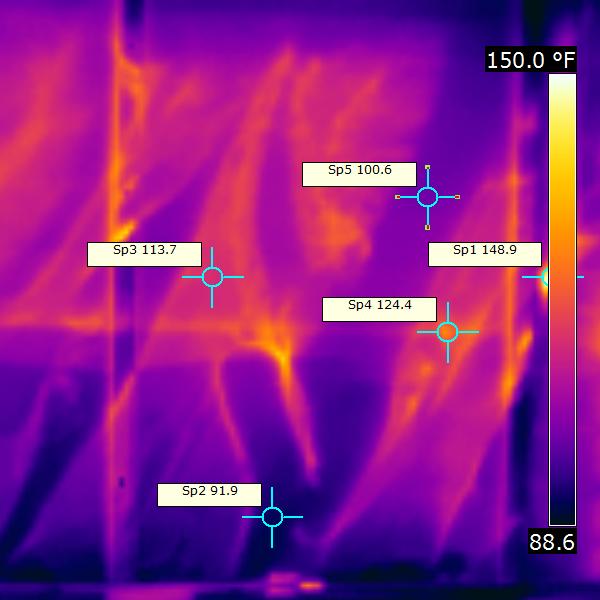
The ripples in the pattern are caused by the Mylar and twinwall not being flat.
Temperatures on the glazing range from about 148F down to 90F.
Recorded Data
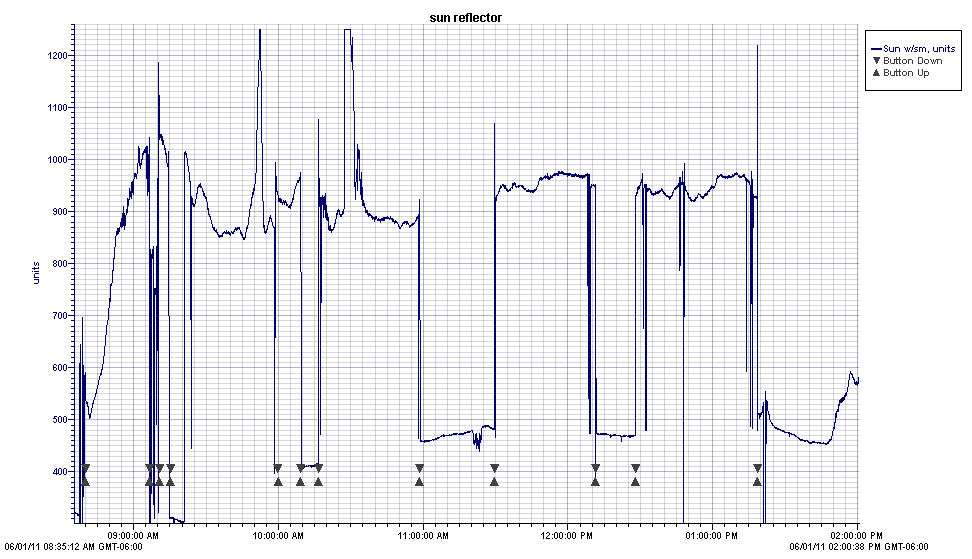
These are the solar intensity readings over the test.
The lower readings (around 470 w/sm) are taken with the pyranometer positioning
arm rotated up so that the pyranometer is on the collector surface but above the
reflected light pattern from the reflector -- so, these are the collector light intensities
from the sunlight only. The higher reading areas (around 950 watts/sm) are
with the pyranometer arm rotated down to place the pyranometer in the reflected
light area of the collector -- so these are reading sunlight plus reflected
light. A simple summary would be that the reflector about doubles
the light
levels and energy input within the reflected light pattern area.
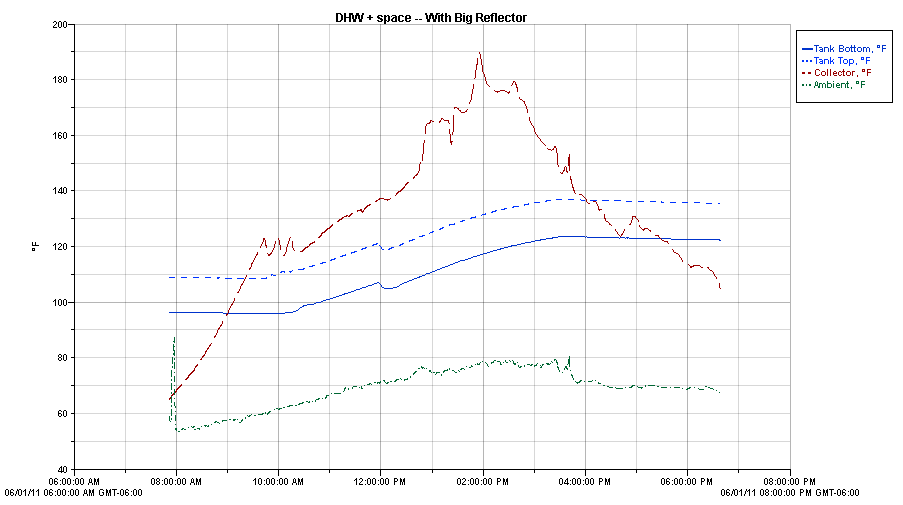
This is a plot showing the tank temperatures for the day.
It shows a nice gain from about 105F up to 130F. This is for about 170
gallons of water in the tank, and includes some use of hot water during the day
-- you can see the dip one long shower at about noon.
Note that the temperature inside the collector gets up to
about 190F -- this peak occurs during the time of day when the reflected
pattern gets high enough on the collector that the collector temperature sensor
is in the reflected light pattern. While the collector is certainly
capable of withstanding higher temperatures than this, it does give a bit of
pause about what the no flow stagnation temperature might be, and is another
reason for keeping the size of the reflector moderate.
Comparable Day Without Reflector
The plot just below is two days later than the plot above
and without the reflector. So, comparing the two similar days, the one
above with reflector and the one below without reflector:
- Tank temperature increase with reflector was 25F,
without reflector was 10F (so about 2.5 times as much heat added to tank)
The two days seem quite comparable to me: ambient
temps about the same, wind light on both days, sun levels were actually a bit higher
on the day without the reflector. The tank starting temperature on the no
reflector day was a bit higher, but on the reflector day, the tank climbed
up through that temperature to end well above the no reflector day. If
anything, I think the day with no reflector was a better solar day.
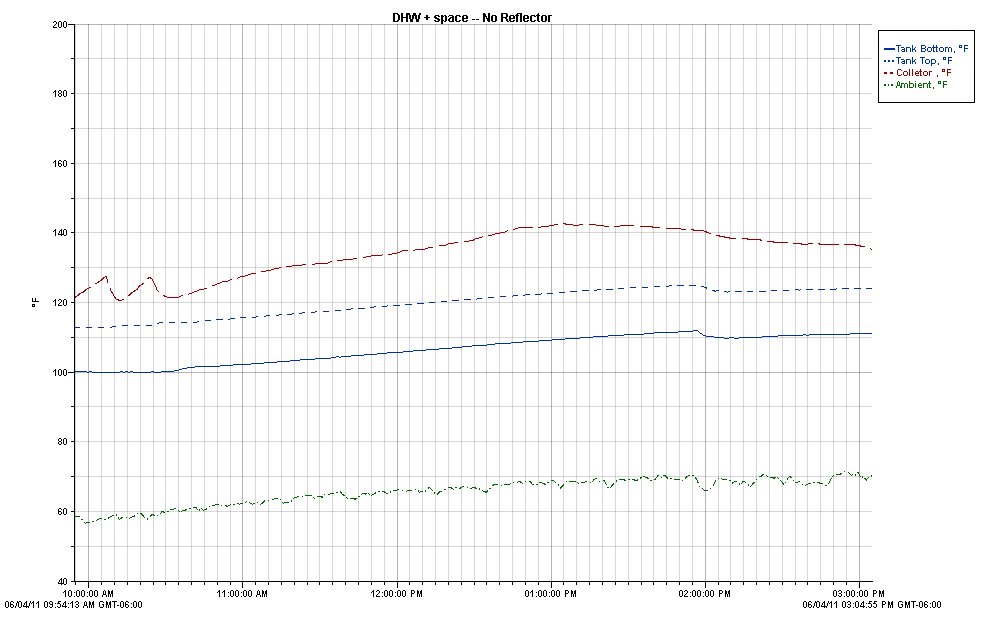
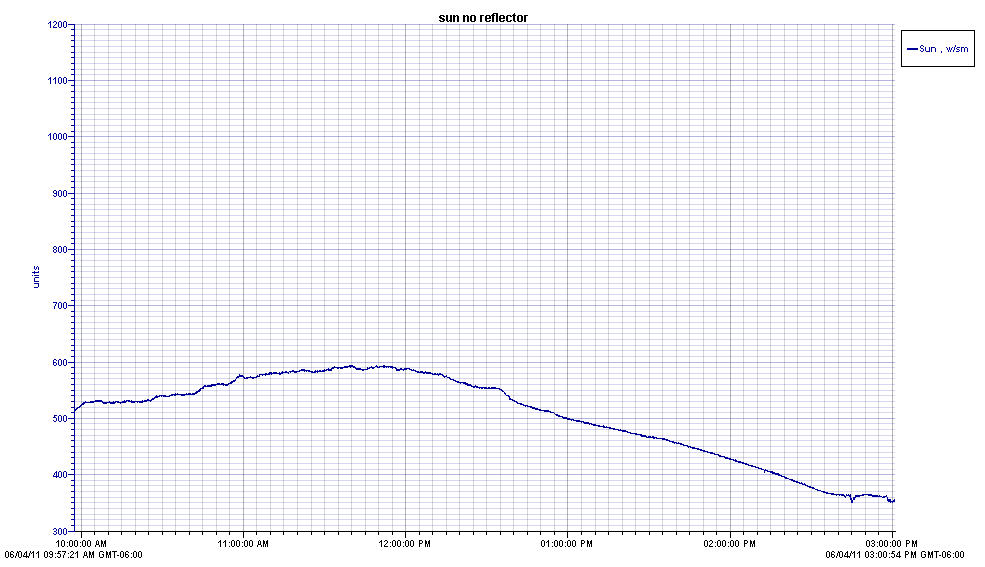
Conclusions
When you look at the results for the sunny day with reflector and see that
the reflector results in a doubling of radiation levels over a significant
portion of the collector, and then look at the 2nd test on a very similar day
and see the tank temperature rise for the day of 10F vs 25F for the reflector
test day, it seems pretty conclusive that adding the reflector results in a very
significant gain in performance.
The actual tank temperature gain for the reflector was actually greater than
the measured increase in radiation levels due to the reflector. This may be
due in part to the fact
that the reflector increases the energy input into the collector without
increasing the heat losses out of the collector glazing significantly -- this
should result in an efficiency improvement. Stating this another way, the
efficiency of this kind of collector when the solar input is 1000 w/sm is about
52% while the efficiency with 500 w/sm is about 32% (these are both with
ambient temp of 60F, and absorber temp of 120F --
per this
calculator...) This is a key advantage of reflectors
that I don't think gets enough attention or credit.
In the end, I will try a "production" version of the collector that is
smaller and (hopefully) looks a lot better, but I am optimistic that this will
address the problem of marginal output in the spring.
It should be remembered that for a vertical collector, the most effective
season to use a reflector is in the summer when the sun is high. In the
winter, the same reflector with a different angle will have some benefit, but
not as much as it does in the summer. See the
main reflector page for more on evaluating reflector gain by season.
Comparisons to Other Reflector Sizing Studies
It is interesting (maybe) to compare these results to the
S. Baker table of benefits of a
reflector in front of a vertical south facing collector.
If you look at the first table where the reflector length is half of the
collector height, for 44 degrees latitude, the benefit for June is 75% and this
is for the case where the collector makes a 90 degree angle with the reflector.
This benefit of 75% is also what they show for collector where L/H = 1.0 and L/H
= 1.5 -- so, they show no benefit in the summer for longer reflectors. When the sun elevation is around 65 degrees, the reflection from parts
of a reflector longer than half the height of the collector are reflected above
the top of the collector. I think that if they had shown angles less than
90 degrees in the table, that the longer reflectors (L/H>0.5) would have shown
more than the 75% improvement. Since I don't have access to the original
paper, I don't know why they did not show angles where the reflector is tilted
at less than 90 degrees.
Comparing the results of this test with the test on the earth-sum simulator
of a square, south facing, vertical collector with a same size square reflector.
The earth-sun simulator shows the radiation
level on the collector with reflector to be 3.2 times the level without collector,
whereas, the levels measure in the test above show the level on the collector
with reflector to be 2.1 times greater than without reflector.
So, this is a fair bit of difference. Some of the reasons for the
difference might be:
- We are still 3 weeks short of the summer solstice, so
the sun will be a bit higher at the solstice and that will drop radiation levels
on the collector surface (according to the sun chart for our area, this is
about 5 degrees of solar elevation).
- The wall the collector is on faces 20 degrees east of
south, so when the sun is shinning directly on the collector (12:11pm) it has
not made its highest elevation for the day (the sun chart shows this to be about
6 degrees of elevation difference).
- The ground area in front of the collector is fairly
light, so the whole collector area probably benefits a little in reflected
radiation from this -- this decreases the difference between with and without
reflector.
- Both tests are, of course, subject to some error.
Accounting for the first two items above would drop the 3.2 down to about 2.3
-- so, that accounts for quite a bit of the difference.
Gary June 4, 2011









